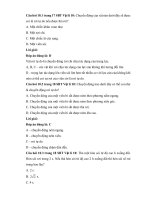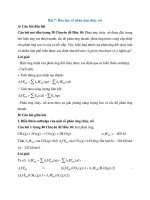Multiple choice ch 7 2 unemployment
Bạn đang xem bản rút gọn của tài liệu. Xem và tải ngay bản đầy đủ của tài liệu tại đây (34.44 KB, 2 trang )
Chapter 28
Unemployment
Sec00 - Unemployment
MULTIPLE CHOICE
1.
4.
10.
To maintain their standard of living, most people rely on
a. government assistance.
b. their personal savings.
c. their labor earnings.
d. rental income.
The amount of unemployment that an economy normally experiences is called the
a. average rate of unemployment.
b. natural rate of unemployment.
c. cyclical rate of unemployment.
d. typical rate of unemployment.
Cyclical unemployment is closely associated with
a. long-term economic growth.
b. short-run ups and downs of the economy.
c. fluctuations in the natural rate of unemployment.
d. changes in the minimum wage.
Sec01 - Unemployment - Identifying Unemployment
MULTIPLE CHOICE
35.
41.
80.
The sum of which of the following must be equal to the adult population?
a. employed, unemployed
b. employed, unemployed, labor force
c. employed, unemployed, not in the labor force
d. employed, unemployed, labor force, not in the labor force
The labor-force participation rate measures the percentage of the
a. total adult population that is in the labor force.
b. total adult population that is employed.
c. labor force that is employed.
d. labor force that is either employed or unemployed.
Suppose that the adult population is 4 million, the number of unemployed is 0.25 million, and the labor-force
participation rate is 75%. What is the unemployment rate?
a. 6.25%
b. 8.3%
c. 9.1%
d. 18.75%
Sec02 - Unemployment - Job Search
MULTIPLE CHOICE
1.
Job search
a. is one reason economies always experience some unemployment.
b. is the process of matching workers with appropriate jobs.
c. would not be a problem if all workers and all jobs were the same.
d. All of the above are correct.
Sec03 - Unemployment - Minimum-Wage Laws
MULTIPLE CHOICE
2.
When a minimum-wage law forces the wage to remain above the level that balances supply and demand, it
a. raises the quantity of labor supplied and raises the quantity of labor demanded compared to the
equilibrium level.
b. raises the quantity of labor supplied and reduces the quantity of labor demanded compared to the
equilibrium level.
c. reduces the quantity of labor supplied and raises the quantity of labor demanded compared to the
equilibrium level.
d. reduces the quantity of labor supplied and reduces the quantity of labor demanded compared to the
equilibrium level.
Sec04 - Unemployment - Unions and Collective Bargaining
MULTIPLE CHOICE
8.
When a union raises the wage above the equilibrium level, it
a. reduces both the quantity of labor supplied and the quantity of labor demanded, resulting in
unemployment.
b. reduces the quantity of labor supplied and raises the quantity of labor demanded, resulting in
unemployment.
c. raises the quantity of labor supplied and reduces the quantity of labor demanded, resulting in
unemployment.
d. raises both the quantity of labor supplied and the quantity of labor demanded, resulting in
unemployment.
Sec05 - Unemployment - The Theory of Efficiency Wages
MULTIPLE CHOICE
3.
4.
Which of the following causes of unemployment is associated with a wage rate above the market equilibrium
level?
a. minimum-wage laws
b. unions
c. efficiency wages
d. All of the above are correct.
Which of the following causes of unemployment is not associated with a wage rate above the market
equilibrium level?
a. efficiency wages
b. job search
c. minimum-wage laws
d. unions




